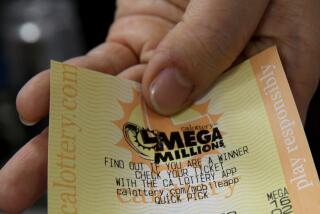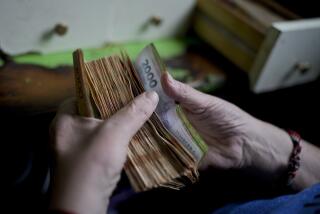Retooling the Money Machines
- Share via
Jim Rowton has seen only a dozen or so of the new $5 bills that are plastered with the off-center, familiar face of Abraham Lincoln.
Rowton’s livelihood relies on Honest Abe. He runs the All Amusement Fun Centers, one of which is located in Van Nuys, where hundreds of kids exchange their allowance money for game tokens every day.
But Rowton’s business is one of many in Los Angeles that doesn’t have the software needed to recognize the new currency. The release of the new $5 and $10 bills--which the federal government announced for “mid-2000”--has sent some businesses and public agencies scrambling to fix their machines to accept the revised currency.
“We were told that [by Thursday] we will have the software to make our changers compliant with the new bills,” Rowton said. “It’s important that we have this because most of what we do is token-based. But so far, we haven’t seen a lot of the bills.”
Businesses were preparing for the new wave of bills, the third time in the last four years the Treasury Department has changed the paper currency to reduce counterfeiting. The federal agency announced in April that the notes would be released May 24. Some organizations were caught off-guard and had only four weeks to adapt. Apparently not everyone heard the news.
“Our Los Angeles office has been inundated with phone calls,” said Barry O’Brien, vice president of Standard Change-Makers Inc., one of the nation’s largest manufacturers of change machines. O’Brien said the Indianapolis-based company received the new bills in February from the Treasury Department to update its product line.
He noted that while the industry manufacturers knew the federal agency’s timeline, other businesses probably did not. “We knew it was coming, although a lot of people didn’t think it was going to be this soon.”
The largest public transit provider in Los Angeles, the Metropolitan Transportation Authority, planned to replace the bill-receptor software this summer. Agency spokesman Ed Scannell said the transit agency was notified in late February of the new release date.
In January, the agency started researching the bill-conversion process. It was the first time the MTA had to deal with the currency change, because its machines only accept bills up to $5.
The MTA even considered several other alternatives because the parts needed to accept the new bills are incompatible with the agency’s existing machines, Scannell said.
“It’s like taking a Toyota made 10 years ago and putting in a new transmission,” he said. “It’s not as easy as it appears.”
Scannell said the MTA board at its June 22 meeting will probably vote to allocate $255,000 to modify and install the equipment and the accompanying software at its 52 stations. The work will be phased in over the next two months, he added.
Meanwhile, the notes are circulating, forcing the transit agency to place signs on the machines warning that, for the time being, the new bills will be rejected. Even machines at the new Metro Red Line subway in North Hollywood, due to open June 24, won’t take the new bills.
“We were caught by surprise,” said Scannell, who said there haven’t been any customer complaints yet. “Our goal is to make the conversion as quickly as possible. It’s not something we started looking into a couple of weeks ago.”
Even a federal agency was caught flat-footed by the release of the new bills. At Los Angeles post offices, where customers can feed vending machines to purchase stamps, only about 25% of the 1,100 machines are equipped to handle the new currency, said U.S. Postal Service spokesman David Mazer. He estimates it will be another month before all of the machines are Abe-friendly.
Unlike the MTA, the U.S. Postal Service has posted signs indicating which machines can accept the bills. Machines without the signs will reject the bills. But it doesn’t hurt to try, Mazer said.
“Just try it a couple of times,” he said. “If it doesn’t work, try it a third time just to make sure.”
The new money has also wreaked havoc on businesses in Ventura County. From vending machines to coin laundries, the race to update bill scanners is on.
Signs posted at the Village Carousel, a video arcade at Ventura Harbor Village, warn customers that the cash machines will not give change for any of the redesigned money and direct them to a cashier for change.
“When I read about it in the paper, I thought we’d have a couple of months before they showed up,” said Jean Mack, manager of the arcade. “And there they were.”
The Marina Village Wash and Dry in Ventura was ready for the arrival of the new greenbacks. The laundry has already upgraded the computer chips of its money readers to allow the machines to accept the money, attendant Avril McLaren said.
The Treasury Department created an awareness program to prepare businesses for the release of the new currency. The department distributed signs for stores to display that inform the public about the changes in the new bills, the first time two notes have been released concurrently. A spokesman for the department said the joint release was done primarily because manufacturers didn’t want to retrofit their machines at a later time.
Prior to their release, the federal agency improved and issued newly designed $20, $50 and $100 bills. About 640 million $5 notes and 493 million $10 notes have been printed, according to the Treasury Department. The first shipment of the bills was sent out two weeks ago to banks. Over the next month, people will probably see more of the currency that will eventually replace the older notes.
But there are future wrinkles for the new bills. The Bureau of Engraving and Printing will change the security features of the notes every few years to throw off counterfeiters. In turn, companies producing change machines will have to make adjustments to their software.
“We don’t necessarily like it,” said O’Brien of Standard Change-Makers Inc. “It’s a cost to us and our customers. But I think over the long run it’s worth it.”
*
Times staff writer Aaron Sanderford contributed to this story.
More to Read
Inside the business of entertainment
The Wide Shot brings you news, analysis and insights on everything from streaming wars to production — and what it all means for the future.
You may occasionally receive promotional content from the Los Angeles Times.










